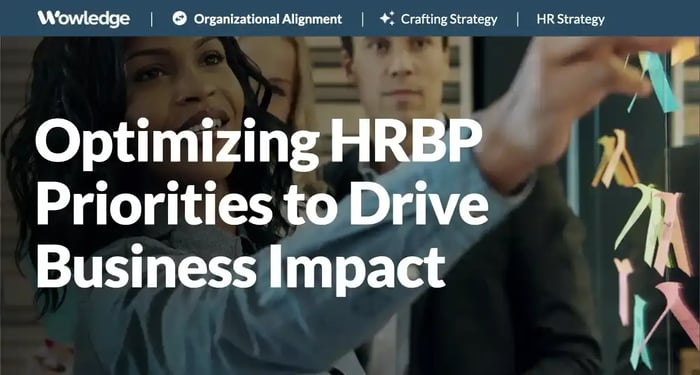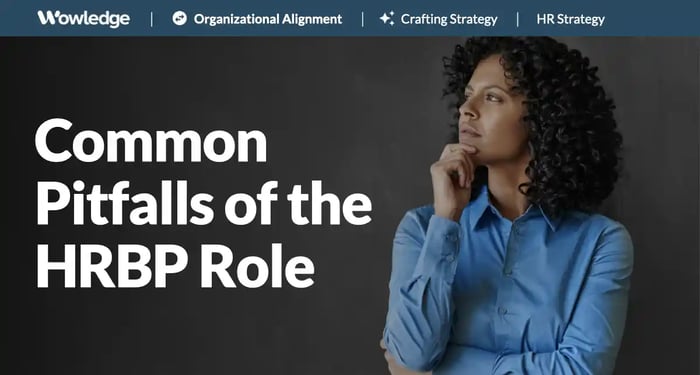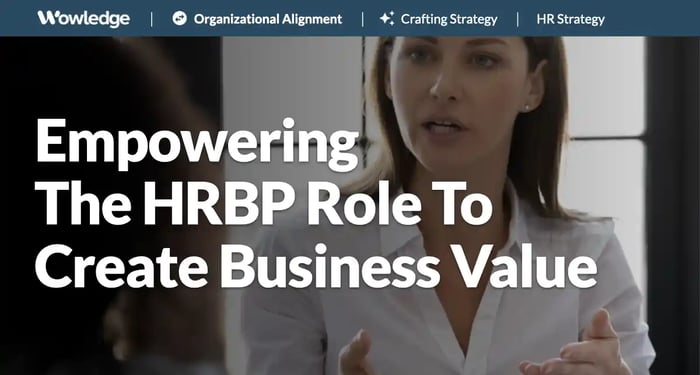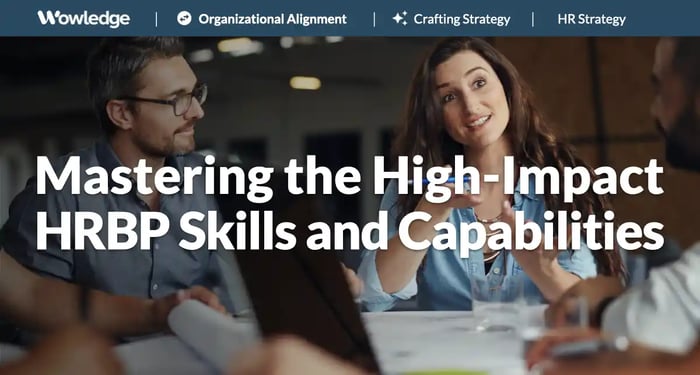Table of Contents
- Defining the role
- Disagreement exists over the roles and responsibilities of an HRBP
- The range of activities that a strategic HR business partner can focus on is extremely broad
- Focusing on priority activities
- What should the HRBP focus on for maximum impact?
- Create ongoing skills-based development for HRBPs
- A special note on “people advocacy” or “employee champion” roles
- Relevant Practices & Tools
- FAQs
-
Much has been written and studied about the HR Business Partner (HRBP) role since the mid-1990s, with much of the thinking emanating from Dave Ulrich’s seminal book Human Resource Champions. While the role has continued to evolve and a wide range of opinions and permutations exist for its structure and responsibilities, it tends to be centered on a number of key attributes across organizations of all sizes and shapes. But what are the HRBP priorities to which any organization should aspire?
The key aspects of this role continue to involve some combination of strategic partner, change agent, administrative expert, and employee champion. These roles can vary based upon a number of factors in any given organization but generally include responsibilities for strategic planning and intervention, talent management optimization, culture development, employee experience, and managerial coaching.
Without question, a well-designed and executed HRBP role can have a positive impact on both people and business outcomes. Gartner reports that those companies that build high-performing HRBPs improve employee performance by up to 22%, employee retention by up to 24%, revenue by up to 7%, and profit by up to 9%.
However, it also found that 82% of HRBPs are ineffective performing strategic activities, and 61% of them cannot effectively prioritize those activities. So the key questions come down to what are the key HRBP priorities that should be assigned to create the greatest impact on the business.
Defining the role
A great deal of variability exists in how an organization should define and implement the role. As a starting point, SHRM defines the role as follows:
“The HR Business Partner (HRBP) position is responsible for aligning business objectives with employees and management in designated business units. The position formulates partnerships across the HR function to deliver value-added service to management and employees that reflects the business objectives of the organization. The HRBP maintains an effective level of business literacy about the business unit's financial position, its midrange plans, its culture and its competition.”
Next, consider the elements of the HR competency model that Dave Ulrich’s team at RBL have updated:
- Accelerating business. Taking an outside-in look to recognize market conditions that shift the HR agenda.
- Advancing human capability. Defining what HR contributes to business discussions and how it enables those goals through human capability.
- Mobilizing information. Focusing on how HR leverages new technologies and the data they generate to inform decision-making.
- Fostering collaboration. Leveraging one’s interpersonal skills and credibility to form trusted relationships with leaders and employees.
- Simplifying complexity. Using critical thinking to assess and set priorities that matter the most to the objectives of the organization.
The role itself is generally expected to use unique expertise and insights into the intersection of human capability and business imperatives to contribute to targeted business outcomes. But that gets clouded by the wide variety of possible responsibilities, historical beliefs and biases regarding the role of HR, and the mix of stakeholders and their demands. That places the HR professional in the often-untenable position of defining and distributing its delivery requirements effectively. Identifying HRBP priorities is therefore essential.
Disagreement exists over the roles and responsibilities of an HRBP
There are many permutations and opinions regarding the HRBP role. Disagreement exists over the role, primarily around the extent to which it has Human Resources administrative or employee-facing duties. Key questions relate to whether the HRBP manages the function or operates as an individual contributor; whether it “owns” and drives talent acquisition and training/development or simply provides input, direction and requests to the specialists in those areas; and the extent to which it is responsible for individual employee relations and policy inquiries/concerns.
The considerations that go into determining the “right” mix of skills include:
The position level
Is the incumbent the overall head of HR (e.g., CHRO), a business unit HR leader, or a function/location partner? This will determine if it is a management or individual contributor role.
The existing level of support from the larger HR organization
The extent to which centers of excellence (e.g., such as Compensation, Recruiting, etc.) and/or shared services (e.g., benefits, HRIS, health and safety) exist, and the range and sophistication of services and expertise each of those provide. Those will determine whether the HRBP is an integrator/requestor of services or a designer and deliverer of the same.
Level of role maturity and expectations
The degree to which the HRBP roles are staffed with broadly experienced, business-savvy team members, with capabilities and expertise across the range of HR capabilities. This drives the extent to which the HRBP can deliver as a strategic partner vs. merely an HR generalist.
The desired level of accountability for managers
The preference for how independent and accountable managers are to manage their teams and policies. The more that is expected from line or functional managers, the more the HRBP is a coach or advisor. HRBP staffing levels also impact this.
What is common is the expectation that the HRBP priorities are designed to primarily interface with management, with the question being the portion of time that is spent in advisory and consultative activities. The evolution of the HRBP has focused on increasing the strategic business-driving contributions, leveraging broad HR expertise to address talent challenges, and syndicating the combination of HR expertise and operational understanding to strengthen managerial capabilities.

The range of activities that a strategic HR business partner can focus on is extremely broad
Strategic HR business partners play a crucial role in aligning human resources initiatives with an organization's strategic objectives. To effectively fulfill their role, HRBP priorities can include diversion of their attention to quite a few key areas, including:
1. Strategic Alignment
HRBPs need to understand the organization's overall strategic direction and objectives. They should work to align HR initiatives and programs with business strategies to ensure that HR activities directly contribute to achieving organizational goals. Keeping a continuous eye on how the HR objectives link to both existing and emerging/future business goals and directions is core to the role.
2. Talent Management
Developing and implementing effective talent management strategies is essential. This involves attracting, recruiting, developing, and retaining top talent. HR business partners should collaborate with leaders to identify critical skills and competencies required for success, create succession plans, and drive or implement talent development programs.
3. Change Management
Organizations frequently undergo changes, such as mergers, acquisitions, or restructuring. HR business partners should facilitate change management efforts by supporting leaders in communicating changes, managing employee transitions, and addressing any potential resistance. They can also assist in designing and implementing change initiatives to foster a positive and adaptive culture.
4. Performance Management
HRBPs should work with leaders to establish performance management systems that align individual and team goals with organizational objectives. This includes providing guidance on goal setting, performance measurement, feedback mechanisms, and performance improvement plans. They can also identify training and development needs to enhance employee performance.
5. Employee Engagement and Experience
Fostering a positive work environment and high employee engagement is crucial for organizational success. HRBPs should focus on initiatives that enhance employee enrichment, motivation, and satisfaction. This can include conducting employee surveys, developing recognition programs, promoting work-life balance, inclusion, and facilitating communication channels between management and employees.
6. HR Analytics
Leveraging data and analytics continues to be an increasingly important differentiator in HR. HRBPs should develop analytical capabilities to measure and track HR metrics and key performance indicators (KPIs) that are linked (statistically) to business outcomes. By analyzing data on employee turnover, recruitment effectiveness, training impact, managerial effectiveness, and other relevant metrics, they can provide insights to support evidence-based decision-making and identify areas for improvement.
7. Leadership Development
HR business partners should collaborate with leaders to drive improvement in managerial capabilities and outcomes. They should focus on identifying and developing high-potential employees for future leadership roles. This involves early career identification processes, designing leadership development programs, providing coaching and mentoring, and supporting succession planning efforts. They should also facilitate leadership training initiatives to enhance the overall leadership capabilities within the organization.
8. Compliance and Ethics
HR business partners should ensure that HR practices and policies comply with applicable laws and regulations. They should stay updated on employment legislation, monitor compliance with labor standards, and promote ethical behavior throughout the organization.
9. Culture management
The assessment, monitoring, and maintenance of corporate culture is considered a critical element of an HRBP's role. Promoting a unified and consistent sense of purpose, effective leadership, communications and feedback, engaging diversity and inclusion, growth and development, as well as employee well-being create a value proposition that attracts and retains the right people.
While the HRBP priorities are oriented towards primarily designing and delivering strategic support, the role often also includes elements of employee relations case management, handling policy and practice inquiries, managing the organization’s administration of HR programs and processes (e.g., annual performance management and merit pay, benefits re-enrollment), an so on. Depending on the scale and sophistication of the HR team, these are often required activities that take the HRBP priorities away from strategic planning and initiative development. So, the key to maximizing the impact of the role comes down to prioritization.
Focusing on priority activities
Given that the HRBP role tends to be lightly populated while having such a high ceiling for potential impact, identifying the key activities for focus is essential. Interesting and useful insights have been generated by researchers over the years that provide insights into the areas that HRBP priorities should include.
For example, previous research conducted by Bersin and Associates found that 1) providing decision support for leaders, 2) developing workforce strategy and mobility planning, and 3) coaching executives and managers were activities that drove the greatest impact on HR organizational efficiency, effectiveness, and business alignment.
Similarly, research by Gartner revealed that the maximum impact in HR-Line support effectiveness was achieved by those companies that focused on, 1) developing the next generation of leaders, 2) understanding the talent needs of the business, and 3) identifying talent issues before they impact the business among other elements. Interestingly, the effects of those were five to ten times (5-10X) more impactful than traditional HR support related to communicating policies and procedures, enforcing HR policies and procedures, and responding to employee questions.

What should the HRBP focus on for maximum impact?
While the duties and responsibilities of an HRBP will vary based on the business needs, management preferences, and existing HR capabilities, some activities will yield greater impact than others. Setting priorities and objectives and regularly monitoring them for continued relevance to the business are essential elements for optimizing the value proposition of the HRBPs in any organization. Key areas of HRBP focus should include:
1. Business alignment
Focus efforts on developing and driving HR objectives and strategies that align directly with business priorities. Conduct workforce planning, skill requirements assessments, and leverage consulting skills to assess and introduce interventions that are designed to drive the achievement of specific business outcomes. Create a focus on building organizational capabilities and structures tied directly to long-term strategic business directions; do that by developing projections for future talent requirements and creating plans to acquire or develop the necessary skills and capabilities. This is the top priority.
2. Strengthening leadership capabilities
Create a culture of leadership excellence by providing robust leadership coaching, talent analytics and insights, leadership development, high potential identification, succession management, and team-building support. Focus attention on balancing people and operational management, increasing managers’ awareness of the direct links between the two with a combination of metrics and work improvement experimentation. The goal is to syndicate the combined HR and business expertise that HRBPs provide to create a cadre of better-prepared and capable leaders and managers. With benchmarks for employees per HRBP ranging from 1:500 to 1:1000 or more, coaching leaders at scale is a necessity.
3. Optimizing employee experience and talent management
Leverage employee experience, engagement, and outcome measurement to track and assess the quality of talent management processes that touch all employees. Focus efforts on improving the processes, programs, and systems that matter the most to the employee experience, and affect their productivity, performance, and perceptions. Use Design Thinking, Six Sigma, Lean and other methodologies to identify improvement opportunities and solutions. Reinforce the focus on these by fully integrating HR processes and systems, such that every aspect of the employee value proposition is achieved.
4. Driving and advocating for a positive and constructive organizational culture
Understand and promote corporate values and communicate those widely and regularly. Integrate those across HR, talent, and business processes, policies, and practices. Incorporate them into leadership and managerial expectations, goals, performance standards, and effectiveness metrics. Strive to provide employees with a sense of purpose and meaningfulness in their work through job design, goal-setting processes, and external/community involvement and contributions. Manage organizational transformation and support the continuous evolution and agility of the company through the use of robust change management strategies. Leverage data to provide the insights necessary to identify barriers to success and potential solutions. Create an environment rich with keys to employee retention and engagement.
Create ongoing skills-based development for HRBPs
As the “half-life” or viability of many job skills is now being estimated to become obsolete every few years, continuous development is key for any job, including the HRBP. In fact, Dave Ulrich’s team has estimated that 30 to 40 percent of required HRBP competencies will change every four to five years. The need to focus skills development on emerging realities of managing both a particular business and the full range of talent that it employs can become daunting. It requires a healthy respect and continually developing awareness of the organizational capabilities that are/will be required to:
- Succeed in an industry or marketplace
- Employ people across a broad set of gradually changing job roles
- Respond and adapt to innovations and technological advancements
- Prepare for an evolving strategic direction in a given organization
The skills currently called for by a successful HRBP include those that are focused on being agile, flexible, responsive, and future-focused in one’s job performance. Skills that are related to both HR and industry-specific innovations and disruptions should be high on the list of HRBP’s development plans, especially those related to:
- Internal consulting approaches
- Coaching
- Data analysis and interpretation
- Communications
- Change management
- Cross-cultural awareness
And especially for the more senior HRBP roles, who increasingly need to be ahead of the curve and aware of/prepared for future-focused trends, knowledge pertaining to relevant industry and technology innovations are essential. Further awareness of the latest population and workforce trends, global and local economic, environmental, and socio- and geo-political forces, as well as those related to financial, sales, supply chain, and operations are also considered critical for excellence in the role.
A special note on “people advocacy” or “employee champion” roles
Over the years, these terms have been popular elements of HR role descriptions and competency models. However, while the role of the HRBP has evolved, the definition of advocacy and championing has continued to be misunderstood. HR’s role in the equation is to set up “listening” and measurement systems and mechanisms for the organization and its managers to understand employee needs, desires, preferences, and barriers to success in the aggregate. The “advocacy” is not for worker demands, but rather what they need to succeed, remain with the organization, develop their skills and contribute to organizational success. The role of HR is to provide useful and actionable insights and action plans that reduce the friction employees experience as they manage their way through their work, company processes, and systems. The “advocacy” is actually the removal and redesign of the elements of the work experience that act as barriers to full productivity, development, and exercising of their skills to meet business and customer requirements.
Relevant Practices & Tools
Advanced HR Strategy Practices to Plan for Delivery of Impactful HR Services and Support. >
Advanced HR Strategy is a refined approach to planning long-term HR priorities. It involves increased specificity of plans and goals around key employee groupings... more »
Generating Alignment Between Workforce Planning and Business Strategies. >
Creating business alignment of the workforce planning effort requires both a review of the company's strategic direction and initiatives as well as discussions with leadership... more »
Designing an Organizational Structure to Facilitate Coordination and Effectiveness Across Business Areas and Levels. >
Once organizational design priorities and principles have been identified, an organizational structure should be selected and tailored to meet the needs of the organization... more »
Analyzing Leadership Development Skill and Capability Gaps. >
Once competencies are defined and participants are identified, it is possible to conduct a more detailed needs analysis. This involves collecting data on each potential program participant... more »
The Aggregated Competency Data Gaps Tool: Capture and Compare Average Ratings on Leadership Competencies. >
A template used to identify the aggregated strengths and development needs of a given group of leaders (total, or by level, function, region, etc.) for an annual leadership development... more »
FAQs
How can HRBPs quantify their impact without building an analytics function?
Start with three traceable links: a workforce risk reduced, a capability built, and an organizational performance shift. Tie each to a business proxy measure such as reduced vacancy days in critical roles, business process cycle-time improvements after team restructuring, or first-year retention of targeted hires. Use pre- and post-baseline measures, and simple control-group comparisons where possible. Package the story with one chart and a brief narrative of actions taken.
What is the best way to split responsibilities between HRBPs and COEs?
Centers of Excellence (COEs) should own updated practices and knowledge, design standards, tools, and root-cause analysis methods for complex cases; HRBPs should own business applications, integration across HR fields of expertise, prioritization, and adoption. Decisions follow the “who is closest to impact” rule, with HRBPs framing the problem and COEs proposing options that align with policy and scale. Service charters define turnaround times, inputs required, and success measures. A quarterly joint backlog review prevents duplication and surfaces trade-offs.
Which few metrics should every HRBP track to guide priorities?
Business, financial, and operational impact metrics are always prioritized, with HR measures that have been demonstrated to influence or drive them. Examples such as critical role vacancy days, regrettable turnover in pivotal roles, first-year retention, internal fill rate for key jobs, high potential performance and development, and manager effectiveness signals form a practical core. Add one leading indicator linked to the strategy, such as skills readiness for an upcoming product launch. Each metric needs an owner, a target, and a playbook when thresholds are crossed. Visibility improves action, so keep the set small and consistently reviewed.
How should success for an HRBP be evaluated beyond activity counts?
Success is seen in business outcomes influenced, leadership capability improved, and friction removed from critical talent flows. Evidence includes faster execution of strategic hires, a stronger bench for pivotal roles, and measurable improvements in targeted teams’ performance or retention. Leader feedback should focus on partnership quality, strategic contributions, and problem-solving impact, not on responsiveness alone. Annual reviews combine these signals with a forward plan tied to next year’s business goals.










